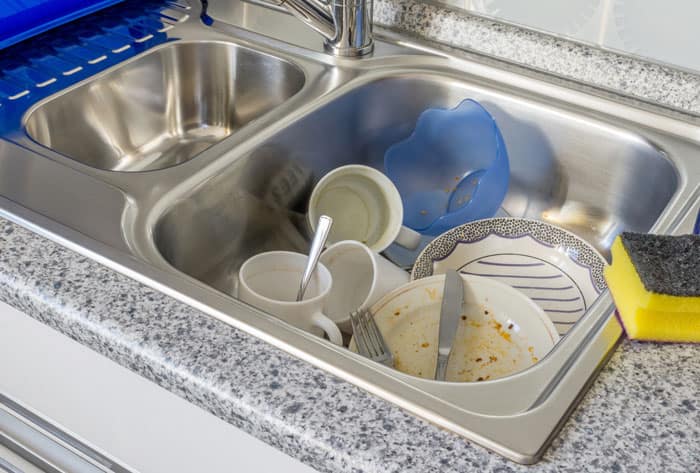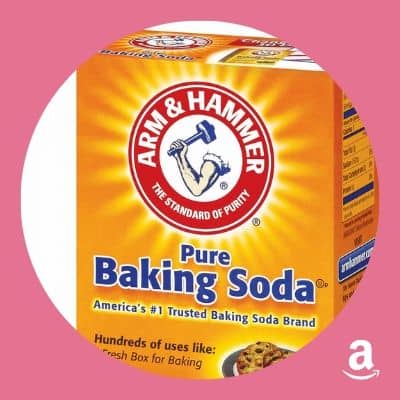The kitchen sink is disgusting. It’s a fact. There are studies to prove it. Gross, right?! But what is the best way to keep our kitchen sink clean and sanitary? I don’t know if there’s a best way to clean a stainless steel sink, but I’ll share how I keep my kitchen sink clean and free from nasty funk. The key is prevention and daily maintenance.

Step 1: Empty the Sink of Dishes and Utensils
I usually clean up my kitchen sink after all the dishes have been loaded into the dishwasher, and the hand-washed items have been washed, dried, and put away. I find it’s much easier (or perhaps it’s just easier on my brain) to clean up the sink area without the worry and mess of dirty dishes hanging around on the counters. I usually give my countertops and appliances a good cleaning and wipe down when I finish with deep cleaning the sink as well.
Got an Instant Pot that gets dirty too? How To Clean Your Instant Pot: The Ultimate Care Guide
Step 2: Get Your Drain Stoppers Soaking
The first thing I always do when I go to deep clean my kitchen sink is to clean and de-gunk the sink stoppers. It’s incredible how much bacteria the stoppers alone can harbor, and they can be easy to forget about. Making it a habit to start with the stoppers as the first part of my sink cleaning routine has never let me forget about them.
You’ll need:
Add hot water, soap, and around a tablespoon of baking soda (full disclosure I eye-ball amounts) to a bowl. Add your rubber sink stoppers and stainless steel drain traps to the bowl so they can soak. Depending on the grossness level, you may want to start this early and let everything soak overnight. Remove the stoppers and drain traps from the solution and use a cleaning brush of some kind – an old toothbrush works well – to scrub them clean. Then rinse with water and dry with a dry cloth – I like to use the yellow microfiber towels from Costco.
Step 3: Clean the Stainless Steel Sink Basin
You’ll need:
Run some hot water from the tap (don’t burn yourself!) and use a sponge or a brush to remove any debris or food bits that may be stuck on the sides of the sink.
Then use a mild-abrasive to scrub the stainless steel. I often use baking soda to get the job done, but if the sink is especially dirty or stained, my go-to is Bar Keeper’s Friend.

Sprinkle the product of your choice all over the sink basin. Use a non-abrasive scrub brush or sponge and scrub in circular motions to remove the grime. Don’t use SOS or steel wool as it can damage your stainless steel sink. Rinse clean with water.
If you are using baking soda, you can give it a spritz of vinegar to create a fizzy reaction to break-down the baking soda before it is rinsed down the drain.
You can also use a cloth to dry the stainless steel sink basin and add a bit of olive oil to buff in to make it shine. I don’t do this part, because, let’s be honest, the sink is going to get used and dirty again within minutes when you have multiple people in a home. Maybe I’ll give it a go when I’m retired…who knows?
Clean Sink Stains with Cream of Tartar
You’ll need:
No matter if you have a porcelain or stainless steel sink, cream of tartar will remove stains quickly and easily. Just spray the sink down with vinegar, then sprinkle on the cream of tartar, and let it sit for a few minutes. Then use a non-abrasive scrub sponge or brush to scrub away any stains. Then rinse with water. A bonus is that cream of tartar makes stainless steel shine, so give it a go on any other stainless steel appliances that need to be cleaned as well.
Step 4: Clean the Sink Faucet and Fixtures

The faucet, as well as the area around where the counter and sink meet, are usually the places that need the most attention in my kitchen. We have hard water that creates tough-to-clean mineral deposits. I love that sparkling clean look around my sink, and a clean faucet just brings it all together. The mixture I use to accomplish this is very simple, yet very effective. Best of all, I don’t need any harsh chemicals.
You’ll need:
Add 1 cup of white vinegar and ¾ cup of blue Dawn to a microwave-safe container. Set the microwave for 1 minute. Gently stir the mixture without creating suds – slow, gentle, and very brief stirring is what we are going for. Then pour into your spray bottle. Spray the counter areas and the faucet with the spray. Let sit for 20 minutes. If necessary, use a brush to scrub away the build-up – it may come up with a cloth as well. Use a damp cloth to wipe away and rinse the soap residue from the surface. Use a dry cloth to shine up the faucet. Repeat if required.
Bonus Tip: This mixture works great for other sinks in your house, cleaning glass shower doors, tile, and bathtubs.
If your faucet spigot has mineral build-up, you can use a sandwich baggie full of vinegar to soak it overnight. Just simply fill the baggie with enough vinegar to keep the spigot submerged then tie it onto the faucet. You can do the same for your sink sprayer if it also has build-up from hard water minerals.
You May Also Like: How To Clean a Shower Head
Step 5: Clean the Sink Drain and Garbage Disposal
Odors from the sink drain or garbage disposal are common and a complaint that you will find across the web. Taking steps to regularly clean your sink drains will go a long way. Show them a little TLC, and you will prevent those nasty odors from becoming a real problem.
If you are like me and keep fresh lemons on hand for cooking, cleaning, or whatnot, then you have the perfect garbage disposal and drain freshener. Just toss the peel into the garbage disposal and give it a quick grind. Mandarin orange peels often work well too. If you have kids that eat lots of mandarin oranges as mine do, it’s a super-easy way to dispose of the peels and freshens the disposal on a regular basis. Win, win.

If you’ve ever reached into the drain to retrieve something, I know you’ve felt it…that slimy gooeyness under there. It’s vile. To clean the nastiness that is the rubber cover, you will need to remove the rubber piece if possible. Use some dish soap and a brush and scrub it really well, rinse, and put it back in the drain, making sure it is properly seated.
If your rubber cover does not come out, you can use a round toilet brush to scrub the underside of the rubber flaps. So as you are brushing away the gunk, be sure not to accidentally fling it in your face…
Prevent Your Kitchen Sink From Becoming a Cesspool of Germs
- Keep dishes, pots, pans, and utensils rinsed and out of the sink basin. Leaving them to sit can also cause rust on your stainless steel sink.
- Don’t allow food scraps or waste to sit in the sink. You will be inviting all the germs and bacteria to party in there. Teach your kids (and spouse if necessary) to rinse everything down the drain AND run the disposal.
- Clean and deodorize your garbage disposal regularly. So much funk can collect in there, so be sure to clean that out often.
- Be sure to disinfect and clean your sink after working with raw meat. Food-borne illness is no joke, and leaving raw meat juice lingering in your sink or on your counters is really bad news.
Look At That Shiny Stainless Steel Sink!
I hope you got some good ideas for how to clean your stainless steel kitchen sink or maybe some new ideas to try out. I don’t know about you, but it always feels better, nice even, to know that my kitchen sink is clean. The idea of festering grossness happening in there makes me want to yak. I do my best to keep my sink and area around it clean at all times. A stainless steel sink is actually quite easy to keep clean if you keep up on it and make it a part of your daily kitchen cleaning routine.

How do you clean your stainless steel kitchen sink? Leave your suggestions in the comments below. We’d love to hear from you!













Leave a Reply